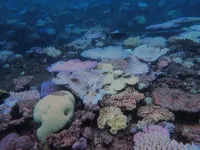Solving the cocktail party problem
Bar-Ilan University researchers move one step closer to understanding how the brain processes multiple conversations at once
2021-05-10
(Press-News.org) Conducting a discussion in a noisy place can be challenging when other conversations and background noises interfere with our ability to focus attention on our conversation partner. How the brain deals with the abundance of sounds in our environments, and prioritizes among them, has been a topic of debate among cognitive neuroscientists for many decades.
Often referred to as the "Cocktail Party Problem", its central question focuses on whether we can absorb information from a few speakers in parallel, or whether we are limited to understanding speech from only one speaker at a time.
One reason this question is difficult to answer is that attention is an internal state not directly accessible to researchers. By measuring the brain activity of listeners as they attempt to focus attention on a single speaker and ignore a task-irrelevant one, we can gain insight into the internal operations of attention and how these competing speech stimuli are represented and processed by the brain.
In a study recently published in the journal eLife, researchers from Israel's Bar-Ilan University set out to explore whether words and phrases are identified linguistically or just represented in the brain as "acoustic noise", with no further linguistic processing applied.
"Answering this question helps us better understand the capacity and limitations of the human speech-processing system. It also gives insight into how attention helps us deal with the multitude of stimuli in our environments - helping to focus primarily on the task-at-hand, while also monitoring what is happening around us," says Dr. Elana Zion Golumbic, of Bar-Ilan University's Gonda (Goldschmied) Multidiciplinary Brain Research Center, who led the study.
Zion Golumbic and team measured brain activity of human listeners as they listened to two speech stimuli, each presented to a different ear. Participants were instructed to focus their attention on the content of one speaker, and to ignore the other.
The researchers found evidence that the so-called unattended speech, generated from background conversations and noise, is processed at both acoustic and linguistic levels, with responses observed in auditory and language-related areas of the brain.
Additionally, they found that the brain response to the attended speaker in language-related brain regions was stronger when it 'competed' with other speech (in comparison to non-speech competition). This suggests that the two speech-inputs compete for the same processing resources, which may underlie the increased listening effort required for staying focused when many people talk at once.
The study contributes to efforts to understand how the brain deals with the abundance of auditory inputs in our environment. It has theoretical implications for how we understand the nature of attentional selection in the brain. It also carries substantial applicative potential for guiding the design of smart assistive devices to help individuals focus their attention better, or navigate noisy environments. The methods developed here also provide a useful new approach for testing the basis for individual differences in the ability to focus attention in noisy environments.
INFORMATION:
ELSE PRESS RELEASES FROM THIS DATE:
2021-05-10
Chemotherapy can induce a painful peripheral neuropathy (CIPN), a chronic condition and common adverse effect for cancer patients undergoing treatment. Researchers at University of California San Diego School of Medicine, with colleagues elsewhere, have used a mouse model to demonstrate the pivotal role of cholesterol in CIPN, and proposed a novel therapeutic approach to reverse it.
The findings are published in the May 10, 2021, online issue of the Journal of Experimental Medicine.
The study was a collaboration between the laboratories of senior study author Yury Miller, MD, PhD, professor of medicine, and Tony Yaksh, PhD, professor of anesthesiology and pharmacology, both at UC San Diego School of Medicine. ...
2021-05-10
Evidence of recent volcanic activity on Mars shows that eruptions could have taken place in the past 50,000 years, according to new study by researchers at the University of Arizona's Lunar and Planetary Laboratory and the Planetary Science Institute.
Most volcanism on the Red Planet occurred between 3 and 4 billion years ago, with smaller eruptions in isolated locations continuing perhaps as recently as 3 million years ago. But, until now, there was no evidence to indicate Mars could still be volcanically active.
Using data from satellites orbiting Mars, researchers discovered a previously unknown volcanic ...
2021-05-10
All three species of manatee now present on Earth share a common ancestor from which they split some 6.5 million years ago, when a huge lake in Amazonia, then linked to the Caribbean, was cut off from the sea. The African manatee Trichechus senegalensis is not as genetically close to the West Indian manatee T. manatus as was thought, and adaptation to this complex environment by the Amazonian manatee T. inunguis has left at least one mark in its genetic code.
These are key findings of a study supported by FAPESP and published in Scientific Reports, with hitherto unknown details of the evolutionary history of these aquatic mammals. The authors are an international group of scientists led by researchers at the University of Campinas ...
2021-05-10
The American College of Chest Physicians® (CHEST) recently released new clinical guidelines on the Diagnosis and Evaluation of Hypersensitivity Pneumonitis (HP). The guidelines contain 14 evidence-based recommendations to improve individual diagnostic decision-making and to decrease diagnostic practice variability.
Occurring at any age, HP is an immunologically mediated form of lung disease resulting from inhalational exposure to a large variety of environmental and/or occupational inciting antigens (typically fungal, bacterial, avian). Over the years, the categorization of HP based on clinical features and disease duration coupled with traditional diagnostic criteria has been unhelpful, even when accurate, when separated from a probabilistic diagnostic ...
2021-05-10
Clavelina oblonga, an invasive marine fouling species, not only reduces diversity in communities it invades, it also interferes in their recovery following natural disasters - a process known as "succession."
Succession refers to how an ecosystem recovers after a disturbance or natural disaster - does the system come back more or less the same as it was in terms of species composition, or is it different?
"The classic example of succession is a forest that experiences a wildfire," says Kayla Christianson, former NC State graduate student and first author of a paper describing the research. "As the community recovers from the fire, it proceeds through a predictable pattern of community development - starting with grasses and ending with trees and a mature forest. This ...
2021-05-10
Since it debuted in 2011, the Get SET Early program, which provides pediatricians and parents with a relatively simple process to screen for indicators of autism spectrum disorder (ASD) in children as young as age 1, has steadily grown in use and validation. Early screening and identification of ASD has been linked to more effective treatment.
A new study, published in the April 26, 2021 issue of the END ...
2021-05-10
PHILADELPHIA-- Human brain organoids are remarkable platforms for modeling features of human brain development and diseases. Building on methods to generate organoids to model different brain regions such as the cortex and the midbrain, researchers at the Perelman School of Medicine at the University of Pennsylvania have generated the first organoids of the arcuate nucleus (ARC), an essential structure in the hypothalamus that sends signals of hunger and feeling full. This part of the hypothalamus exhibits a tremendous amount of cell diversity, and is far more complex than previously modeled parts of the brain.
In a paper ...
2021-05-10
Scientists have made major advances in understanding and developing treatments for many cancers by identifying genetic mutations that drive the disease. Now a team led by researchers at Weill Cornell Medicine, NewYork-Presbyterian and the New York Genome Center (NYGC) has developed a machine learning technique for detecting other modifications to DNA that have a similar effect.
The study, published May 10 in Cancer Discovery, a journal of the American Association for Cancer Research, focuses on a type of chemical modification to DNA, called methylation, that typically silences nearby genes. The new technique can analyze the thousands of DNA methylation changes detected in tumor cells and infer which ones are likely ...
2021-05-10
HOUSTON - Researchers at The University of Texas MD Anderson Cancer Center have developed a first-of-its-kind spatial atlas of early-stage lung cancer and surrounding normal lung tissue at single-cell resolution, providing a valuable resource for studying tumor development and identifying new therapeutic targets. The study was published today in Cancer Discovery, a journal of the American Association for Cancer Research.
The findings reveal a heterogeneous lung cancer ecosystem, with extensive interactions between cancer cells and the surrounding microenvironment that regulate early cancer development. ...
2021-05-10
New research on the growth rates of coral reefs shows there is still a window of opportunity to save the world's coral reefs--but time is running out.
The international study was initiated at the ARC Centre of Excellence for Coral Reef Studies (Coral CoE), which is headquartered at James Cook University (JCU).
Co-author Professor Morgan Pratchett from Coral CoE at JCU said the results show that unless carbon dioxide emissions are drastically reduced the growth of coral reefs will be stunted.
"The threat posed by climate change to coral reefs is already very apparent based on recurrent episodes of mass coral bleaching," Prof Pratchett said. "But changing environmental conditions will have other far-reaching consequences."
Co-author Professor Ryan Lowe, from Coral CoE at The University ...
LAST 30 PRESS RELEASES:
[Press-News.org] Solving the cocktail party problem
Bar-Ilan University researchers move one step closer to understanding how the brain processes multiple conversations at once




